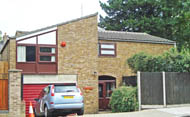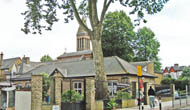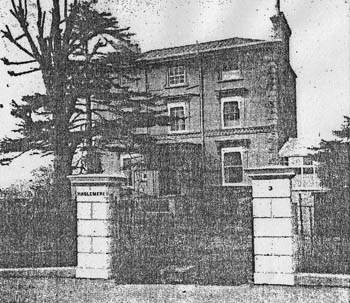Streatham
Red Cross Medical and Surgical Nursing Home
3 Christchurch Road, Streatham SW2 3ET
Medical
dates:
Medical
character:
General
At the end of WW1 the local Red
Cross committee, which had managed the Streatham Auxiliary Red Cross
Hospital,
found it had in its possession a substantial surplus of money. It
decided to buy the former hospital and to adapt it as a modern
nursing home for middle class patients with charges from £3
to 3 guineas (£3.15) a week. Great care was taken to
ascertain that patients could not afford more than 3 guineas, so as not
to undercut the more expensive nursing homes.
The freehold was then bought by the Streatham War Hospital Supply Depot out of its surplus funds and the house presented to the Red Cross Division as a nursing home with 26 beds.
The Streatham Red Cross Medical and Surgical Nursing Home opened in May 1920 with 26 beds. Patients were admitted by their own GPs, who were also responsible for their in-patient treatment.
The Headquarters of the British Red Cross Society had given £1,000 towards initial expenses and the County Branch had also contributed, but the Home was self-supporting by the end of the year.
The nursing staff consisted of a Matron, 3 qualified nurses, 2 paid probationers and a number of former members of the Voluntary Aid Detachment who had worked at the Auxiliary Hospital during the war.
The largest ward held 8 beds, while the other wards varied in size. The walls were papered in soft shades of green or grey. In the women's wards, each bed was curtained to give a degree of privacy if the patient desired. The bed curtains were of a deep shape of heliotrope, while the bedspreads were pink and the bedside mats of soft Persian hues. The men's wards were not curtained, but provided with an ample number of screens. The bedside lockers were of white painted metal, and under each bed was a wooden stool. Each ward had a well-stocked bookcase.
Trays for meals were prepared on each landing, thus relieving congestion in the kitchen at mealtimes. Cupboards and storerooms were available on every floor.
The Nursing Home had ample bathroom and lavatory facilities fitted with the latest sanitary equipment.
The operating theatre, originally equipped for the auxiliary military hospital regardless of expense, by the Streatham Congregational Church, was most up-to-date.
The building had a central heating system, which not only heated the wards and corridors, but also provided hot towel rails, airing cupboards and hot blankets ready for emergency cases.
On the ground floor the conservatory had been fitted as a lounge for use by convalescent patients.
The large kitchen was located in the basement, together with the scullery, the housemaid's closet and the pantry. The sinks were made of teak to protect the crockery.
The Nursing Home had its own ambulance, which had also been purchased by the Streatham Red Cross. This was lodged in the adjoining garage and driven by the factotum who also acted as gardener and porter.
The Nursing Home presumably closed in 1939 at the outbreak of WW2.
The freehold was then bought by the Streatham War Hospital Supply Depot out of its surplus funds and the house presented to the Red Cross Division as a nursing home with 26 beds.
The Streatham Red Cross Medical and Surgical Nursing Home opened in May 1920 with 26 beds. Patients were admitted by their own GPs, who were also responsible for their in-patient treatment.
The Headquarters of the British Red Cross Society had given £1,000 towards initial expenses and the County Branch had also contributed, but the Home was self-supporting by the end of the year.
The nursing staff consisted of a Matron, 3 qualified nurses, 2 paid probationers and a number of former members of the Voluntary Aid Detachment who had worked at the Auxiliary Hospital during the war.
The largest ward held 8 beds, while the other wards varied in size. The walls were papered in soft shades of green or grey. In the women's wards, each bed was curtained to give a degree of privacy if the patient desired. The bed curtains were of a deep shape of heliotrope, while the bedspreads were pink and the bedside mats of soft Persian hues. The men's wards were not curtained, but provided with an ample number of screens. The bedside lockers were of white painted metal, and under each bed was a wooden stool. Each ward had a well-stocked bookcase.
Trays for meals were prepared on each landing, thus relieving congestion in the kitchen at mealtimes. Cupboards and storerooms were available on every floor.
The Nursing Home had ample bathroom and lavatory facilities fitted with the latest sanitary equipment.
The operating theatre, originally equipped for the auxiliary military hospital regardless of expense, by the Streatham Congregational Church, was most up-to-date.
The building had a central heating system, which not only heated the wards and corridors, but also provided hot towel rails, airing cupboards and hot blankets ready for emergency cases.
On the ground floor the conservatory had been fitted as a lounge for use by convalescent patients.
The large kitchen was located in the basement, together with the scullery, the housemaid's closet and the pantry. The sinks were made of teak to protect the crockery.
The Nursing Home had its own ambulance, which had also been purchased by the Streatham Red Cross. This was lodged in the adjoining garage and driven by the factotum who also acted as gardener and porter.
The Nursing Home presumably closed in 1939 at the outbreak of WW2.
Present status (April 2011)
During WW2 the building became the Wandsworth Wartime Day Nursery. After the war it was renamed simply the Wandsworth Day Nursery. In 1967 it became the Lambeth Day Nursery.
The house was demolished and a new vicarage built for the neighbouring Christ Church in the 1970s (the previous vicarage behind Christ Church had suffered bomb damage in 1940 during WW2 and had become uninhabitable).
Half the grounds of Haslemere are now covered by a side entrance and a classroom block of the Christ Church Streatham Primary School.


The modern vicarage at No. 3 Christchurch Road, built around 1970, now occupies the site (left). Part of Christ Church Streatham Primary School occupies the grounds of the former Hospital (right).

Haslemere, 3 Christchurch Road, Streatham, was built in 1860. It was a private residence until 1915, when it became a hotel, and then an auxiliary military hospital.
(Photograph by courtesy of the Streatham Society)
(Author unstated) 1920 Hospitals for the New Poor. British Journal of Nursing 8th May, 276.
Personal communication: Brian Bloice, Judy Harris and John Brown of the Streatham Society. Grateful thanks are offered for their help.
http://landmark.lambeth.gov.uk
www.charitycommission.gov.uk
Return to home page